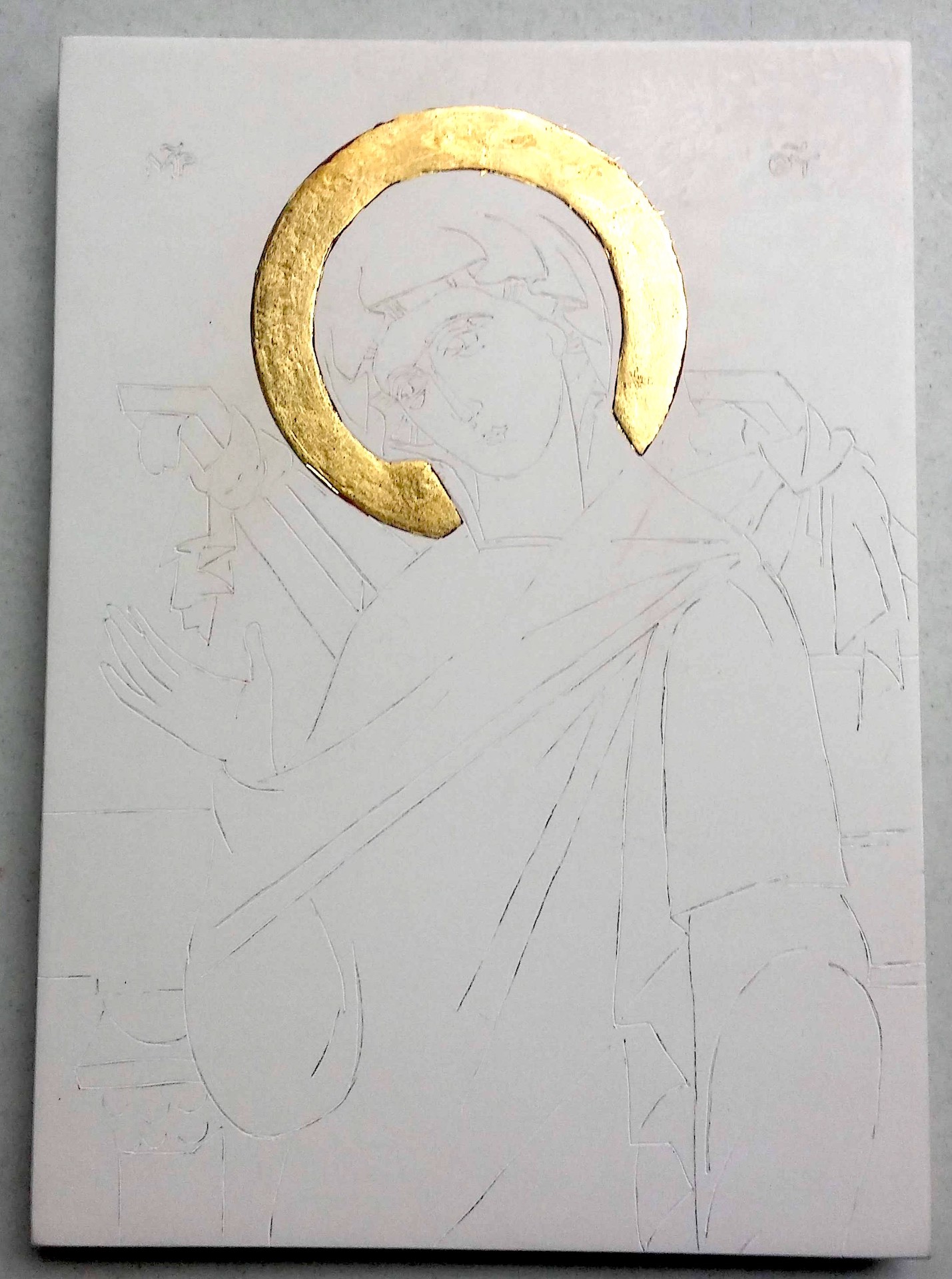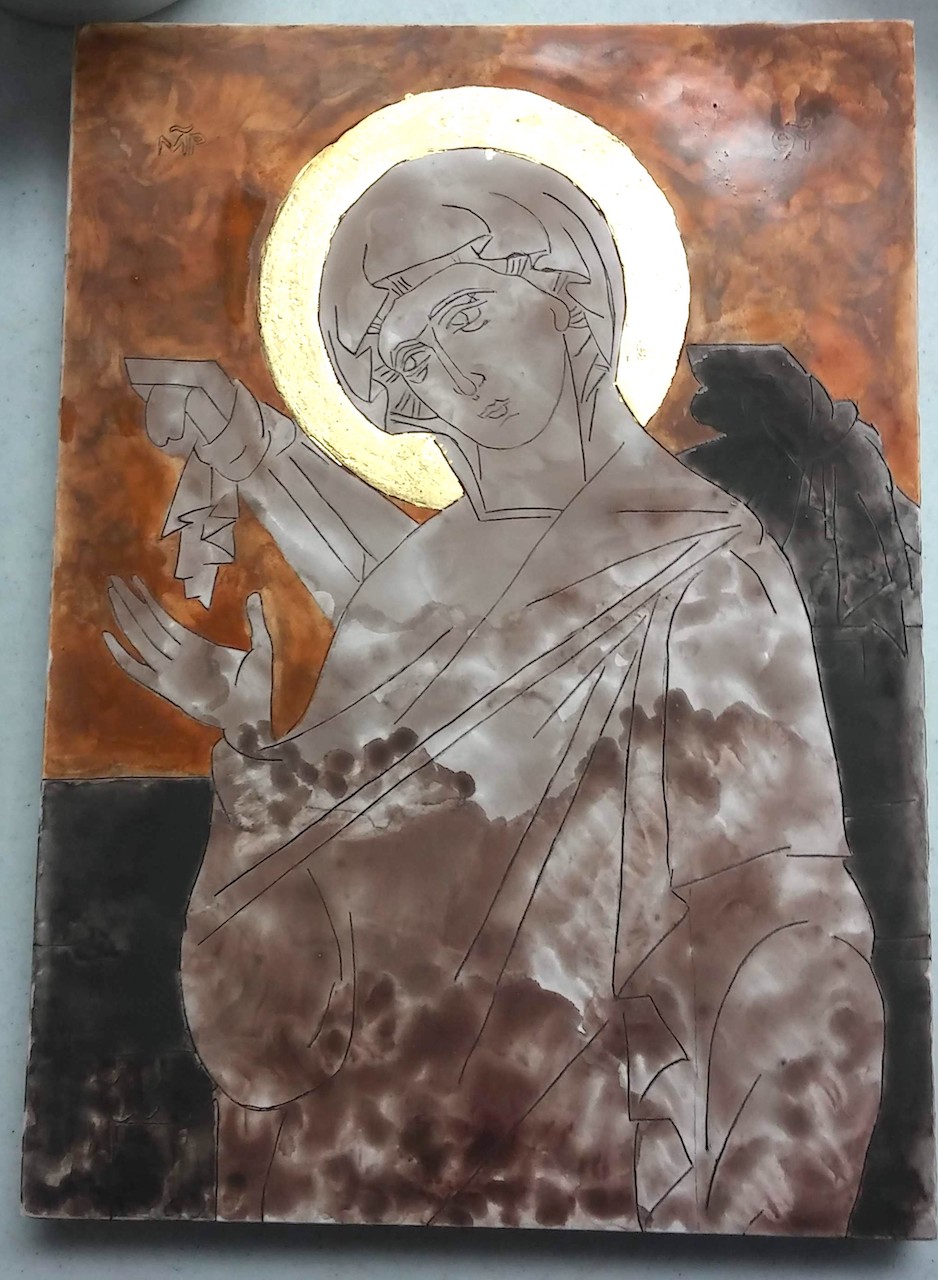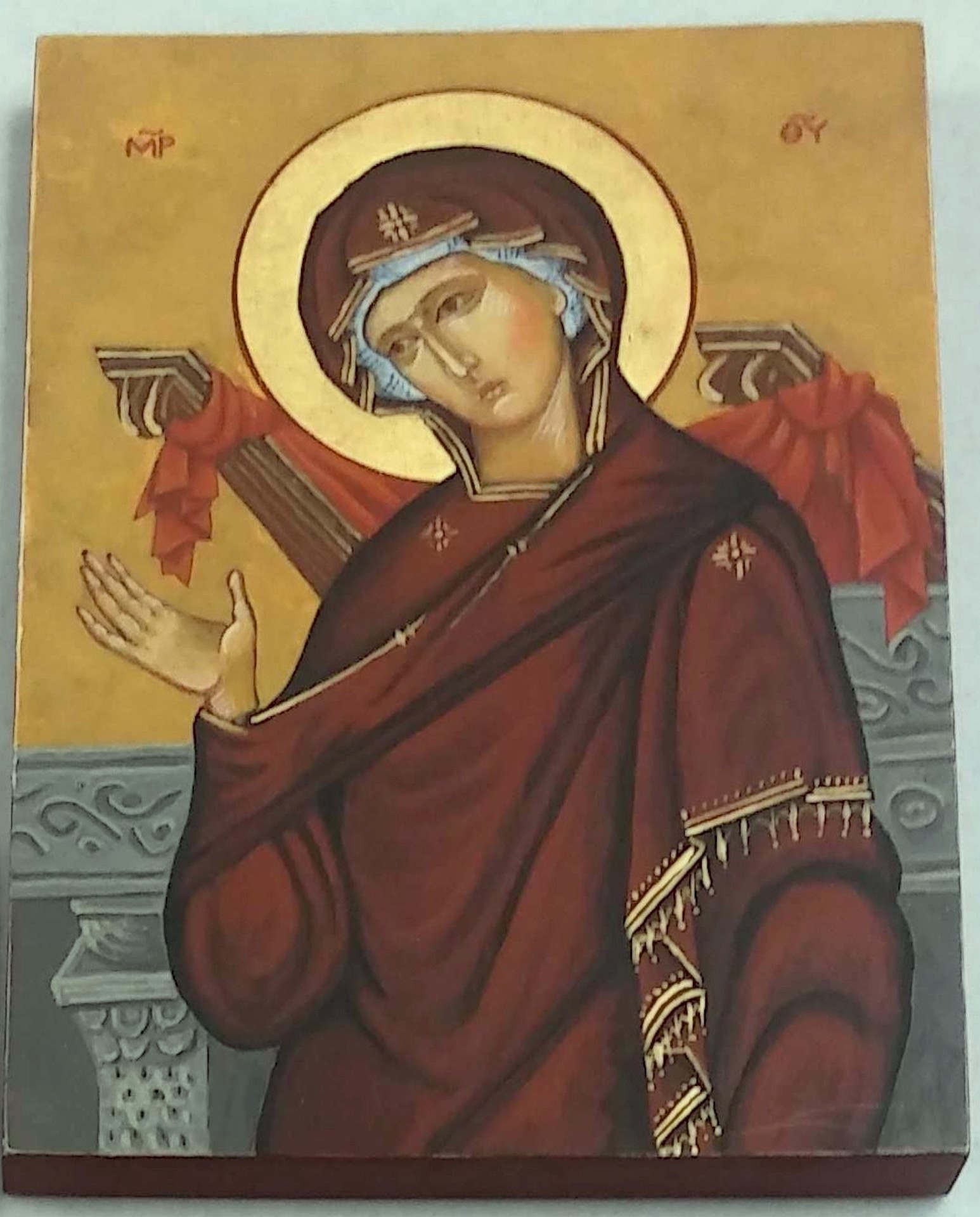Painting the Light
It’s always fun to learn a new art technique, and few art styles have fascinated me more than the ancient Byzantine art - a style with serious and imperturbable faces - so when I had the chance to learn to paint in the Byzantine style from a master teacher - a young artist who works full time as an iconographer - I jumped at the chance! Who knows, I thought, maybe I’d be inspired to use what I’d learned to make a new art lesson for ArtAchieve!
What I learned is that the icon-painting is much more than technique. Instead, it is a process, a process that’s all about meditating on spiritual truths. It’s a process that consciously recaptures the creation story; the techniques of icon painting are set up to make light shine out of darkness.
We began with a prepared wooden board covered in linen that was painted with a mixture of marble dust and rabbit glue. In other words that painting surface held tokens of the entire creation: wood and linen from the plant world, glue from animal world, and marble dust from the mineral world. We would be painting with egg tempera, a paint made from egg yolk, serving as a representative from the world of birds.
Everyone in our workshop painted one of the figures of the Annunciation: the Virgin Mary or the angel Gabriel. My figure was the Virgin Mary. Our first task was to scratch a drawing of our figure into the white surface, and then add a gold leaf coating where the halo was going to be. Gold leafing can be tricky; it’s thin, fragile, and easily torn. I had to patch mine after the first attempt.

Remember that I said that the process recaptures the creation story? The first layer of paint was to paint chaos (. . .“the earth was a formless void” . . .)

And then we painted the darkest color on each area, another reflection of the creation story (. . . “there was darkness over the deep” . . .). One person in the workshop, a professional artist, kept saying, “This is backwards!” Her way of painting, which is a common way in modern painting, is to paint the lightest colors first, and the shadows last.

Then we started adding light to those dark areas. On the robe the darkest red went on first, then a lighter layer, and another and another, until the robe seems to glow with light - but instead of a light that seemed to come from the outside, as in most modern realistic paintings, this was a light that seemed to emanate from inside the figure. The idea of painting this way was to to capture something of what is said of Moses in the Old Testament when he had met with God on Mt. Sinai, “When Aaron and all the Israelites saw Moses, the skin on his face was so radiant that they were afraid to go near him.” (Exodus 34:30)

When the robe, the easiest part to paint, was finished, we were ready to paint the skin of the face and hands, and guess what: again we started with the shadow color and then added the first bit of glow to it.

When all the layers of highlight were finished, the icon was complete.

Obviously, this would be too difficult a process for an 8th grader. Learning to use egg tempera is an education in itself! But the idea of drawing and painting light intrigued me. It was an idea we could for an art lesson for kids.
So I’m choosing a face I found staring down at me from a ceiling high overhead in Wawel Castle in Kraków, Poland, for a Level V art lesson, The Castle Ceiling Head. In imitation of the process we used in the icon painting workshop, we’ll draw with white pencil on black paper. The more white pencil we apply, the more the highlights of the face will glow!

It’s always fun to learn a new art technique, and few art styles have fascinated me more than the ancient Byzantine art - a style with serious and imperturbable faces - so when I had the chance to learn to paint in the Byzantine style from a master teacher - a young artist who works full time as an iconographer - I jumped at the chance! Who knows, I thought, maybe I’d be inspired to use what I’d learned to make a new art lesson for ArtAchieve!
What I learned is that the icon-painting is much more than technique. Instead, it is a process, a process that’s all about meditating on spiritual truths. It’s a process that consciously recaptures the creation story; the techniques of icon painting are set up to make light shine out of darkness.
We began with a prepared wooden board covered in linen that was painted with a mixture of marble dust and rabbit glue. In other words that painting surface held tokens of the entire creation: wood and linen from the plant world, glue from animal world, and marble dust from the mineral world. We would be painting with egg tempera, a paint made from egg yolk, serving as a representative from the world of birds.
Everyone in our workshop painted one of the figures of the Annunciation: the Virgin Mary or the angel Gabriel. My figure was the Virgin Mary. Our first task was to scratch a drawing of our figure into the white surface, and then add a gold leaf coating where the halo was going to be. Gold leafing can be tricky; it’s thin, fragile, and easily torn. I had to patch mine after the first attempt.

Remember that I said that the process recaptures the creation story? The first layer of paint was to paint chaos (. . .“the earth was a formless void” . . .)

And then we painted the darkest color on each area, another reflection of the creation story (. . . “there was darkness over the deep” . . .). One person in the workshop, a professional artist, kept saying, “This is backwards!” Her way of painting, which is a common way in modern painting, is to paint the lightest colors first, and the shadows last.

Then we started adding light to those dark areas. On the robe the darkest red went on first, then a lighter layer, and another and another, until the robe seems to glow with light - but instead of a light that seemed to come from the outside, as in most modern realistic paintings, this was a light that seemed to emanate from inside the figure. The idea of painting this way was to to capture something of what is said of Moses in the Old Testament when he had met with God on Mt. Sinai, “When Aaron and all the Israelites saw Moses, the skin on his face was so radiant that they were afraid to go near him.” (Exodus 34:30)

When the robe, the easiest part to paint, was finished, we were ready to paint the skin of the face and hands, and guess what: again we started with the shadow color and then added the first bit of glow to it.

When all the layers of highlight were finished, the icon was complete.

Obviously, this would be too difficult a process for an 8th grader. Learning to use egg tempera is an education in itself! But the idea of drawing and painting light intrigued me. It was an idea we could for an art lesson for kids.
So I’m choosing a face I found staring down at me from a ceiling high overhead in Wawel Castle in Kraków, Poland, for a Level V art lesson, The Castle Ceiling Head. In imitation of the process we used in the icon painting workshop, we’ll draw with white pencil on black paper. The more white pencil we apply, the more the highlights of the face will glow!

It’s always fun to learn a new art technique, and few art styles have fascinated me more than the ancient Byzantine art - a style with serious and imperturbable faces - so when I had the chance to learn to paint in the Byzantine style from a master teacher - a young artist who works full time as an iconographer - I jumped at the chance! Who knows, I thought, maybe I’d be inspired to use what I’d learned to make a new art lesson for ArtAchieve!
What I learned is that the icon-painting is much more than technique. Instead, it is a process, a process that’s all about meditating on spiritual truths. It’s a process that consciously recaptures the creation story; the techniques of icon painting are set up to make light shine out of darkness.
We began with a prepared wooden board covered in linen that was painted with a mixture of marble dust and rabbit glue. In other words that painting surface held tokens of the entire creation: wood and linen from the plant world, glue from animal world, and marble dust from the mineral world. We would be painting with egg tempera, a paint made from egg yolk, serving as a representative from the world of birds.
Everyone in our workshop painted one of the figures of the Annunciation: the Virgin Mary or the angel Gabriel. My figure was the Virgin Mary. Our first task was to scratch a drawing of our figure into the white surface, and then add a gold leaf coating where the halo was going to be. Gold leafing can be tricky; it’s thin, fragile, and easily torn. I had to patch mine after the first attempt.

Remember that I said that the process recaptures the creation story? The first layer of paint was to paint chaos (. . .“the earth was a formless void” . . .)

And then we painted the darkest color on each area, another reflection of the creation story (. . . “there was darkness over the deep” . . .). One person in the workshop, a professional artist, kept saying, “This is backwards!” Her way of painting, which is a common way in modern painting, is to paint the lightest colors first, and the shadows last.

Then we started adding light to those dark areas. On the robe the darkest red went on first, then a lighter layer, and another and another, until the robe seems to glow with light - but instead of a light that seemed to come from the outside, as in most modern realistic paintings, this was a light that seemed to emanate from inside the figure. The idea of painting this way was to to capture something of what is said of Moses in the Old Testament when he had met with God on Mt. Sinai, “When Aaron and all the Israelites saw Moses, the skin on his face was so radiant that they were afraid to go near him.” (Exodus 34:30)

When the robe, the easiest part to paint, was finished, we were ready to paint the skin of the face and hands, and guess what: again we started with the shadow color and then added the first bit of glow to it.

When all the layers of highlight were finished, the icon was complete.

Obviously, this would be too difficult a process for an 8th grader. Learning to use egg tempera is an education in itself! But the idea of drawing and painting light intrigued me. It was an idea we could for an art lesson for kids.
So I’m choosing a face I found staring down at me from a ceiling high overhead in Wawel Castle in Kraków, Poland, for a Level V art lesson, The Castle Ceiling Head. In imitation of the process we used in the icon painting workshop, we’ll draw with white pencil on black paper. The more white pencil we apply, the more the highlights of the face will glow!









